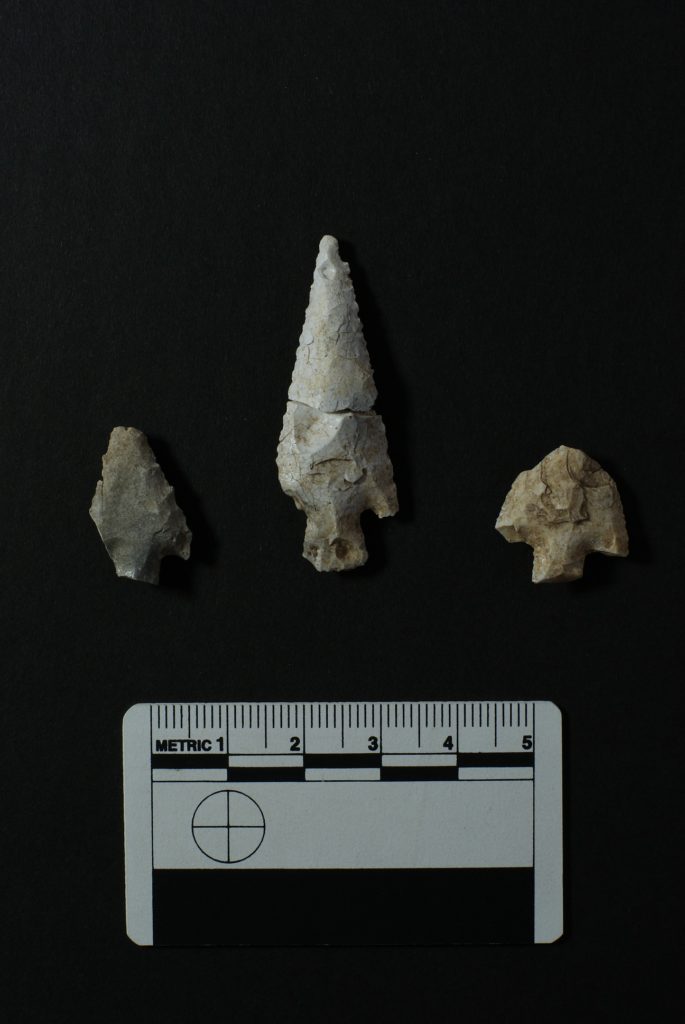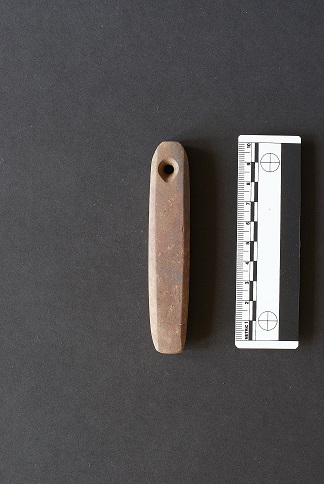Recent excavations at Crieff, Perthshire by CFA-Archaeology Ltd have revealed a Bronze Age funerary complex. A circular cemetery was identified from a cluster of cists, pits, post holes and cremation deposits whilst some 15m to the south there was a separate group of cremation pits and inverted Cordoned Urn burials.
Beautiful and unusual stone objects formed part of the funerary ritual including groups of barbed-and-tanged arrowheads, a perforated stone pendant and stone tools.

A group of seven barbed-and-tanged arrowheads were placed on the cremated bone deposits interred in a large pit in the southern group of features. These arrowheads are in a particular style – based on the use of the Kilmarnock arrowhead template as defined by Stephen Green. However, there is clear variation within this group in terms of flint colour, size, shaping technique and finished shape which may indicate that at least two or maybe three persons contributed to their manufacture.

Another group of three barbed-and-tanged arrowheads of burnt flint was found amongst the cremated remains placed in a Cist from the circular cemetery. The finest arrowhead is narrow and elongated in form and is most similar to Green’s Sutton C type whilst the other two arrowheads are smaller but too heavily damaged from burning to classify.
Are these arrowheads a representation of a hunting kit, not owned by the deceased but made especially for the cremation ritual? Joanna Bruck has commented on the role of artefacts which accompany Early Bronze Age funeral ritual and proposes that they should be viewed as gifts from the mourners representing the character of the inter-personal relationships between them and the deceased. The multiple authorship of the arrowheads from Broich might indicate a small group of people contributing their personally-made gifts to the deceased.

What should we make of this stone pendant found within an inverted Cordoned Urn? This slender, finely-shaped object has been ground all over to form smooth, slightly curved ends, sides and faces with additional grinding down the four long edges to produce distinctive bevels. The perforation is made at one end by twisting or drilling to form a biconical hole. There is subsequent wear around the perforation which is complex and comprises a distinctive reshaping of the outer edge at either end of the perforation and on both faces. Just how this wear pattern was produced is not known; it could not be the product of the pendant simply dangling from a cord as the lower edge is also worn. A possible scenario is for a loop of cord or thin leather to have been pushed through the perforation and then held in place, perhaps with a toggle placed across the width of the pendant. The stone object could then have slid up and down the cord, either deliberately or incidentally through body movement thereby forming the friction-induced wear pattern observed on the pendant.

Stone tools were also found amongst the deposits in the same cremation pit as the group of seven barbed-and-tanged arrowheads.
A cobble with a fine ground facet on one end may have been used to crush the cremated bone.

On this flat cobble two distinctive linear facets have been worn down one side; these are smooth through use as a possible whetstone and they form distinct ridges.
Other flint and stone artefacts were found and a full excavation report will be published soon. In the meantime a lecture on the findings from the cemetery at Broich Road, Crieff was given by Dr Mel Johnson of CFA-Archaeology Ltd to the Archaeological Research in Progress conference 2015. This has been made available online through Archaeology Scotland http://www.archaeologyscotland.org.uk/news/arp-conference-great-success-talks-available-watch